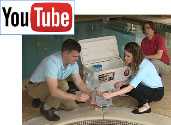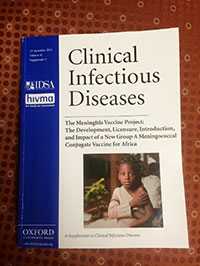Division of Bacterial Diseases (DBD) News Bulletin
Winter 2015
Communications
In This Issue
- World Pneumonia Day
- Travel Safety Reminder, New OD Staff
- Meetings
- Awards, Epi-Aids & Outbreak Investigations
- Communications, Publications

Photo: A series of new Legionella training videos feature DBD’s Laurel Garrison, epidemiologist, and Matt Westercamp, EIS officer, along with CDC environmental health specialist Jasen Kunz.
Meningitis Documentary
Rockhopper Productions’ new meningitis documentary, “Meningitis: A Shot of Hope,” published by PATH programs on YouTube in October 2015, examines the global response to devastating meningitis A outbreaks in Africa and the rapid development of an affordable vaccine to eliminate recurring epidemics.
Public Health Matters Blog
The blog "Keeping Cool Under Pressure: NYC Legionnaires’ Disease Outbreak, Summer 2015" is now available on CDC’s Public Health Matters Blog. The blog highlights the CDC and partner response to the largest community-associated outbreak of Legionnaires’ disease since the pathogen was discovered in 1976.
Legionella Website and Toolkit Launched October, 2015
DBD’s new Legionella website and toolkit, released in October 2015, includes resources for the public, clinicians, laboratorians, environmental health specialists, and media, including six instructional videos on environmental aspects of legionellosis outbreak investigations, and outbreak investigation tools and data collection forms.
Publication Highlights

Image: The special issue of Clinical Infectious Diseases reporting on the Meningitis Vaccine Project.
Meningitis Vaccine Project Special Issue
A special issue of Clinical Infectious Diseases collected outcomes and science from the Meningitis Vaccine Project, including 11 publications with DBD authors:
- Diallo A, Sow SO, Idoko OT, et al. Antibody persistence at 1 and 4 years following a single dose of MenAfriVac or quadrivalent polysaccharide vaccine in health subjects aged 2–29 years. Clin Infect Dis. 2015;61(suppl 5):S521–30.
- Diomandé FV, Djingarey MH, Daugla DM, et al. Public health impact after the introduction of PsA-TT: The first four years. Clin Infect Dis. 2015;61(suppl 5):S467–72.
- Diomandé FV, Yaméogo TM, Vannice KS, et al. Lessons learned from enhancing vaccine pharmacovigilance activities during PsA-TT introduction in African countries, 2010-2013. Clin Infect Dis. 2015;61(suppl 5):S459–66.
- Djingarey MH, Diomandé FV, Barry R, et al. Introduction and rollout of a new group A meningococcal conjugate vaccine (PsA-TT) in African meningitis belt counties, 2010–2014. Clin Infect Dis. 2015;61(suppl 5):S434–41.
- Holme D, Findlow H, Sow SO, et al. Neisseria meningitidis group A IgG1and IgG2 subclass immune response in African children aged 12–23 months following meningococcal vaccination. Clin Infect Dis. 2015;61(suppl 5):S563–9.
- Price GA, Hollander AM, Plikaytis BD, et al. Human complement bactericidal responses to a group A meningococcal conjugate vaccine in Africans and comparison to responses measured by 2 other group A immunoassays. Clin Infect Dis. 2015;61(suppl 5):S554–62.
- Roy Chowdhury P, Meier C, Laraway H, et al. Immunogenicity of yellow fever vaccine coadministered with MenAfriVac in healthy infants in Ghana and Mali. Clin Infect Dis. 2015;61(suppl 5):S586–93.
- Tang Y, Plikaytis BD, Preziosi MP, et al. Influence of age on antibody response and persistence following immunization with MenAfriVac. Clin Infect Dis. 2015;61(suppl 5):S531–9.
- Tapia MD, Findlow H, Idoko OT, et al. Antibody persistence 1–5 years following vaccination with MenAfriVac in African children vaccinated at 12–23 months of age. Clin Infect Dis. 2015;61(suppl 5):S514–20.
- Tapia MD, Sow SO, Haidara FC, et al. A Phase 3, double-blind, randomized, active controlled study to evaluate the safety of MenAfriVac in healthy Malians. Clin Infect Dis. 2015;61(suppl 5):S507–13.
- Vannice KS, Keita M, Sow SO, et al. Active surveillance for adverse events after a mass vaccination campaign with a group A meningococcal conjugate vaccine (PsA-TT) in Mali. Clin Infect Dis. 2015;61(suppl 5):S493–500.
Emerging Infections Program Theme Issue
A special issue of Emerging Infectious Diseases documented 20 years of achievements from CDC’s Emerging Infections Program, including four publications with DBD authors:
- Langley G, Besser J, Iwamoto M, et al. Effect of culture-independent diagnostic tests on the future of Emerging Infections Program surveillance. Emerg Infect Dis. 2015;21(9):1582–8.
- Langley G, Schaffner W, Farley MM, et al. Twenty years of Active Bacterial Core surveillance. Emerg Infect Dis. 2015;21(9):1520–8.
- Moore MR, Whitney CG. Use of pneumococcal disease epidemiology to set policy and prevent disease during 20 years of the Emerging Infections Program. Emerg Infect Dis. 2015;21(9):1551–6.
- Skoff TH, Baumbach J, Cieslak PR. Tracking pertussis and evaluating control measures through enhanced pertussis surveillance, Emerging Infections Program, United States. Emerg Infect Dis. 2015;21(9):1568–73.
Diaz MH, Benitez AJ, Winchell JM. Investigations of Mycoplasma pneumoniae infections in the United States: Trends in molecular typing and macrolide resistance from 2006 to 2013. J Clin Microbiol. 2015;53(1):124–30.
Edison L, Beaudoin A, Goh L, et al. Scabies and bacterial superinfection among American Samoan children, 2011–2012. PLoS ONE. 2015;10(10):e0139336.
Faulkner A, Skoff TH, Tondella L, et al. Trends in U.S. pertussis diagnostic testing, 1990–2012. Pediatr Infect Dis J. 2015 Sep 24. [Epub ahead of print].
Grijalva CG, Wunderink RG, Zhu Y, et al. In-hospital pneumococcal polysaccharide vaccination is associated with detection of pneumococcal vaccine serotypes in adults hospitalized for community-acquired pneumonia. Open Forum Infect Dis. 2015;2(4):ofv135.
Hao Y, Balluz L, Strosnider H, et al. Ozone, fine particulate matter, and chronic lower respiratory disease mortality in the United States. Am J Respir Crit Care Med. 2015;192(3):337–41.
Jauregui B, Felix Garcia AG, Janusz CB, et al. Evidence-based decision-making for vaccine introductions: Overview of the ProVac International Working Group’s experience. Vaccine. 2015;33(s1):A28–33.
Metcalf BJ, RE Gertz, RA Gladstone, et al. Strain features and distributions in pneumococci from children with invasive disease before and after 13-valent conjugate vaccine implementation in the United States. Clin Microbiol Infect. 2015 Sep 10. [Epub ahead of print].
Mustapha M, Marsh J, Krauland M, et al. Genomic epidemiology of hypervirulent serogroup W, ST-11 Neisseria meningitidis. EBioMedicine. 2015;2(10):1294–5.
Nix EB, Williams K, Cox AD, et al. Naturally acquired antibodies against Haemophilus influenzae type a in aboriginal adults, Canada. Emerg Infect Dis. 2015;21(2):273–9.
Petrone BL, Wolff BJ, DeLaney AA, et al. Isothermal detection of Mycoplasma pneumoniae directly from respiratory clinical specimens. J Clin Microbiol. 2015;53(9):2970–6.
Piralam B, Tomczyk SM, Rhodes JC, et al. Incidence of pneumococcal pneumonia among adults in rural Thailand, 2006–2011: Implications for pneumococcal vaccine considerations. Am J Trop Med Hyg. 2015 Oct 26. [Epub ahead of print].
Skoff TH, Kenyon C, Cocoros N, et al. Source of infant pertussis infection in the United States. Pediatrics. 2015;136(4):635–41.
Weigand MR, Changayil S, Kulasekarapandian Y, et al. Complete genome sequences of two Bordetella hinzii strains isolated from humans. Genome Announcement. 2015;3(4):e00965–15.
Wolff BJ, Morrison SS, Pesti D, et al. Chlamydia psittaci comparative genomics reveals intraspecies variations in the putative outer membrane and type III secretion system genes. Microbiology. 2015;161(7):1378–91.
- Page last reviewed: January 15, 2016
- Page last updated: January 15, 2016
- Content source:


 ShareCompartir
ShareCompartir